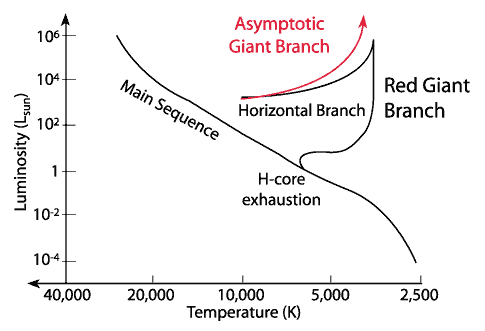asymptotic giant branch

Evolutionary track of a Sun-like star from main sequence to asymptotic giant branch. Image credit: NOAO.
The asymptotic giant branch (AGB) is a region of the Hertzsprung-Russell diagram that lies above and roughly parallel (hence the name "asymptotic") with the red giant region. It is occupied by evolved stars of low to intermediate mass (0.8 to 8 solar masses) that have a tiny, dormant core of carbon and oxygen surrounded by a helium and hydrogen burning shell, and then an enormous convective envelope. Somewhat confusingly, although AGB stars do not lie on the red giant branch, they are often referred to as being red giants because they are large and red in color.
The Sun will eventually become an AGB star. An example of a star currently on the asymptotic giant branch is R Sculptoris.
Evolution of an AGB star
Initially, the hydrogen-fusing shell of an AGB star is responsible for most of the star's energy output. However, the hydrogen shell eventually dumps enough helium "ash" onto the helium shell that the latter undergoes an explosive event called a thermal pulse. Although this pulse is barely noticed at the surface of the star, it serves to increase the mass of the carbon/oxygen core, so that the size and luminosity of the star gradually increases with time.
As the star climbs the AGB, it becomes a pulsating variable of the type known as a Mira variable. A wind develops in the star's envelope that blows the outer layers into space at a rate of 10-8 to 10-4 solar mass per year. Within this wind, dust particles (crucial to the development of interstellar clouds and, eventually, protoplanetary systems) are formed from carbon material dredged up from the core by convection currents. Also through this mass loss, AGB stars avoid ending as supernovae. When the envelope of the star is nearly gone, a time of enhanced loss with a rapid velocity produces a protoplanetary nebula, which evolves to become planetary nebula. The stellar core left behind is a white dwarf of 0.6 to 0.7 solar mass.


